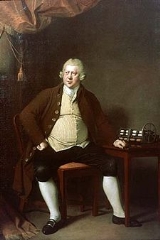
Richard Arkwright
Overview
Spinning frame
The spinning frame is an Industrial Revolution invention for spinning thread or yarn from fibers such as wool or cotton in a mechanized way. It was developed in 18th century Britain by Richard Arkwright and John Kay.-Historical context:...
— later renamed the water frame
Water frame
The water frame is the name given to the spinning frame, when water power is used to drive it. Both are credited to Richard Arkwright who patented the technology in 1768. It was based on an invention by Thomas Highs and the patent was later overturned...
following the transition to water power
Hydropower
Hydropower, hydraulic power, hydrokinetic power or water power is power that is derived from the force or energy of falling water, which may be harnessed for useful purposes. Since ancient times, hydropower has been used for irrigation and the operation of various mechanical devices, such as...
. He also patented a carding
Carding
Carding is a mechanical process that breaks up locks and unorganised clumps of fibre and then aligns the individual fibres so that they are more or less parallel with each other. The word is derived from the Latin carduus meaning teasel, as dried vegetable teasels were first used to comb the raw wool...
engine that could convert raw cotton
Cotton
Cotton is a soft, fluffy staple fiber that grows in a boll, or protective capsule, around the seeds of cotton plants of the genus Gossypium. The fiber is almost pure cellulose. The botanical purpose of cotton fiber is to aid in seed dispersal....
into yarn
Yarn
Yarn is a long continuous length of interlocked fibres, suitable for use in the production of textiles, sewing, crocheting, knitting, weaving, embroidery and ropemaking. Thread is a type of yarn intended for sewing by hand or machine. Modern manufactured sewing threads may be finished with wax or...
. A self-made man, he was a leading entrepreneur of the Industrial Revolution
Industrial Revolution
The Industrial Revolution was a period from the 18th to the 19th century where major changes in agriculture, manufacturing, mining, transportation, and technology had a profound effect on the social, economic and cultural conditions of the times...
. Arkwright's achievement was to combine power, machinery, semi-skilled labour, and a new raw material (cotton) to create, more than a century before Ford
Henry Ford
Henry Ford was an American industrialist, the founder of the Ford Motor Company, and sponsor of the development of the assembly line technique of mass production. His introduction of the Model T automobile revolutionized transportation and American industry...
, mass produced yarn.
Unanswered Questions

